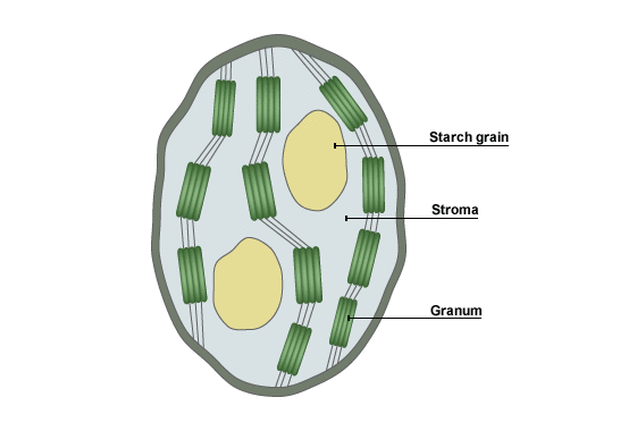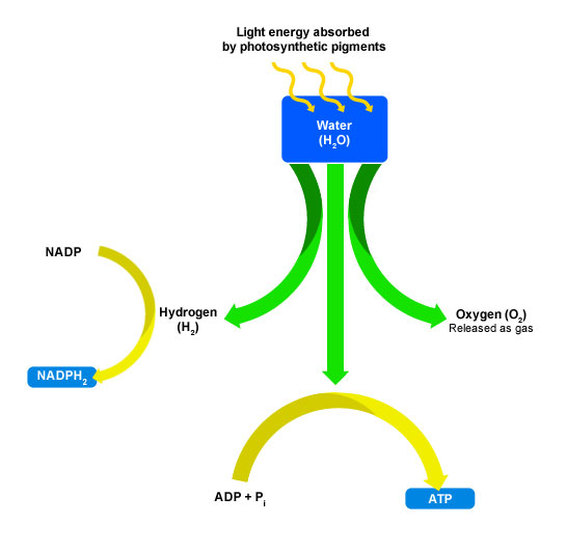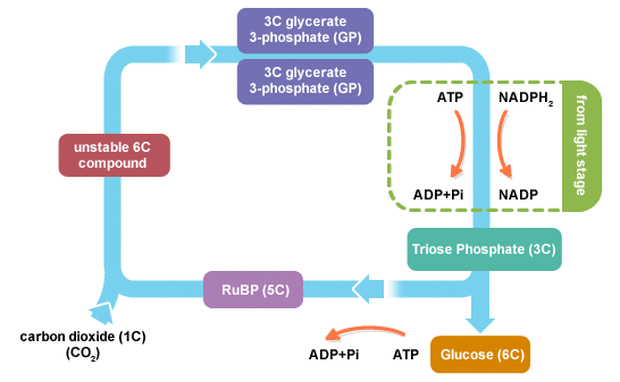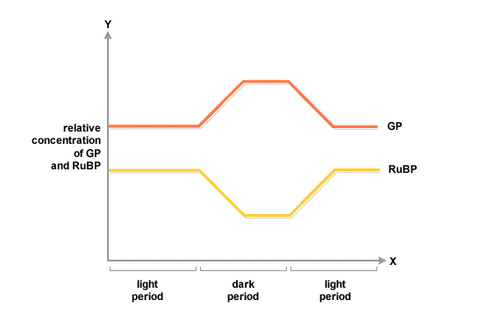The chloroplast in photosynthesisThe chloroplasts are the organelles where the two stages of photosynthesis take place.
The structure of the chloroplast
The granum (plural grana) is a stack of membranes which contains the photosynthetic pigments; this is where the light dependent stage takes place:
The following video clip is an explanation of the importance of photosynthesis.
The granum (plural grana) is a stack of membranes which contains the photosynthetic pigments; this is where the light dependent stage takes place:
- The pigments are chemicals which absorb light energy and convert it to chemical energy.
- The principal pigment is chlorophyll a.
- Chlorophyll a absorbs light mainly in the red and blue regions.
- Accessory pigments such as chlorophyll b, xanthophyll and carotene absorb light from other regions of the spectrum and pass the energy onto chlorophyll a.
- The accessory pigments broaden the absorption spectrum so that more energy is available for photosynthesis.
The following video clip is an explanation of the importance of photosynthesis.
The light dependent stage
This stage takes place in the granum.
Light energy is absorbed by chlorophyll and is used to regenerate adenosine tri-phosphate or ATP and split water. This is called the photolysis of water. Photolysis of water results in the release of oxygen, as a by-product, and the release of hydrogen. The hydrogen released from the water molecule is transferred to the hydrogen acceptor. NADP becomes reduced to form NADPH2.
The products of the light stage are ATP and NADPH2.
The hydrogen and ATP are used in the carbon fixation reactions:
Light energy is absorbed by chlorophyll and is used to regenerate adenosine tri-phosphate or ATP and split water. This is called the photolysis of water. Photolysis of water results in the release of oxygen, as a by-product, and the release of hydrogen. The hydrogen released from the water molecule is transferred to the hydrogen acceptor. NADP becomes reduced to form NADPH2.
The products of the light stage are ATP and NADPH2.
The hydrogen and ATP are used in the carbon fixation reactions:
- ATP provides the energy for the reactions.
- NADPH2 provides the hydrogen for the reduction of carbon dioxide to form carbohydrate.
Carbon fixation (The Calvin Cycle)
Carbon fixation stage in photosynthesis
The carbon fixation stage occurs in the stroma and results in the production of glucose.
It is a result of an enzyme controlled sequence of reactions requiring ATP and hydrogen (NADPH2) from the light stage, and carbon dioxide. It involves the reduction of carbon dioxide, that is the addition of hydrogen, to form carbohydrate.
The carbon fixation stage occurs in the stroma and results in the production of glucose.
It is a result of an enzyme controlled sequence of reactions requiring ATP and hydrogen (NADPH2) from the light stage, and carbon dioxide. It involves the reduction of carbon dioxide, that is the addition of hydrogen, to form carbohydrate.
- CO2 is accepted by the 5C compound ribulose 1,5-biphosphate (RuBP) to form an unstable 6C compound.
- The 6C compound formed immediately splits into two molecules of a 3C compound called glycerate 3-phosphate (GP).
- Energy is used to convert GP into triose phosphate, a 3 carbon compound. It is at this point that the ATP and hydrogen produced in the light dependent stage are used.
- Triose phosphate doubles up to form glucose. Glucose may then be used in either respiration to provide energy, stored as starch, or used to synthesise cellulose for cell walls.
- The cycle is completed when the leftover GP molecules are met with a carbon acceptor and converted into RuBP, which is then joined with carbon dioxide to re-start the cycle.
- Proteins
- Fats
- Carbohydrates
- Nucleic acids
The limiting factors of photosynthesis
There are three main limiting factors in photosynthesis:
- Lack of carbon dioxide. If there is no carbon dioxide available RuBP cannot be converted into GP. As a result the RuBP starts to build up and no more glucose will be produced.
- Low temperatures. These limit photosynthesis since the enzymes controlling the reactions are below their optimum temperature.
- Lack of light. In the absence of light neither the ATP or the NADPH2 will be produced and so the GP cannot be converted into glucose. This results in the GP building up and the RuBP being used up.
Photosynthesis exam skills
Many of the more difficult questions in this topic are set in a problem solving context.
Example 1
The limiting factors of photosynthesis
Many of the more difficult questions in this topic are set in a problem solving context.
Example 1
The limiting factors of photosynthesis
Question
What is the factor which is limiting the rate of photosynthesis at point X on the graph?
Answer
Light intensity
Commentary: In any question on limiting factors, the factor on the X axis remains a limiting factor for as long as the graph continues to rise; in this case the point at which it levels off. At this point photosynthesis may still be limited by other factors such as temperature or carbon dioxide concentration.
What is the factor which is limiting the rate of photosynthesis at point X on the graph?
Answer
Light intensity
Commentary: In any question on limiting factors, the factor on the X axis remains a limiting factor for as long as the graph continues to rise; in this case the point at which it levels off. At this point photosynthesis may still be limited by other factors such as temperature or carbon dioxide concentration.
Question
Account for the increase in the rate of photosynthesis in graph 1 when the temperature is raised from 20 degrees C to 30 degrees C.
Answer
The enzymes controlling photosynthesis are nearer or at their optimum temperature.
Commentary: Giving an account means to explain and not simply describe the rate increase.
Account for the increase in the rate of photosynthesis in graph 1 when the temperature is raised from 20 degrees C to 30 degrees C.
Answer
The enzymes controlling photosynthesis are nearer or at their optimum temperature.
Commentary: Giving an account means to explain and not simply describe the rate increase.
Question
Name an environmental factor other than temperature which may be limiting the rate at point Y.
Answer
Carbon dioxide concentration
Commentary: Here giving one of the other limiting factors would be sufficient in your answer.
Name an environmental factor other than temperature which may be limiting the rate at point Y.
Answer
Carbon dioxide concentration
Commentary: Here giving one of the other limiting factors would be sufficient in your answer.
Example 2
Absorption and action spectra
Absorption and action spectra
Absorption spectrum of chlorophyll
The graph shows the absorption spectrum of chlorophyll a and the rate of photosynthesis over the same range of wavelengths.
The graph shows the absorption spectrum of chlorophyll a and the rate of photosynthesis over the same range of wavelengths.
Question
What evidence on the graph indicates that chlorophyll a is not the only pigment involved in photosynthesis?
Answer
The rate of photosynthesis is high at wavelengths when the absorption by the pigment is low.
or
The rate of photosynthesis is high at wavelengths such as 450 nm and 650 nm where the absorption is low.
Commentary: You are expected to use the data provided in support of your answer.
What evidence on the graph indicates that chlorophyll a is not the only pigment involved in photosynthesis?
Answer
The rate of photosynthesis is high at wavelengths when the absorption by the pigment is low.
or
The rate of photosynthesis is high at wavelengths such as 450 nm and 650 nm where the absorption is low.
Commentary: You are expected to use the data provided in support of your answer.
Example 3
Question
What evidence from the graph supports the statement that GP can be converted to RuBP in the light?
Answer
The GP concentration decreases as the RuBP increases.
Commentary: The question asks you to provide evidence from the light period. Answers giving the changes which take place in the dark are not appropriate.
What evidence from the graph supports the statement that GP can be converted to RuBP in the light?
Answer
The GP concentration decreases as the RuBP increases.
Commentary: The question asks you to provide evidence from the light period. Answers giving the changes which take place in the dark are not appropriate.






